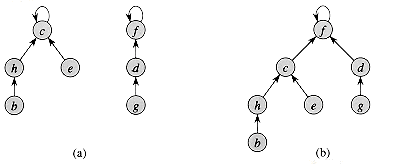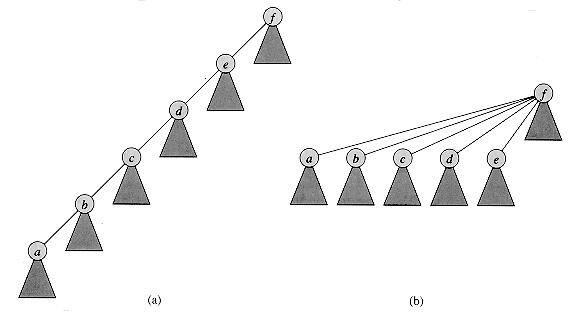不相交集合森林的启发式策略
在文章《Union-Find 操作检测无向图有无环算法》中介绍了 Union-Find 算法的一个简单实现,使用一维数组来处理不相交集合数据结构(Disjoint-set data structure)。
Union-Find 算法为该数据结构提供了两种非常有用的操作:
- Find:判断子集中是否存在特定的元素。可以用于检测是否两个元素存在于相同的子集中。
- Union:将两个不子集合并成新的子集合。
1 private int Find(int[] parent, int i) 2 { 3 if (parent[i] == -1) 4 return i; 5 return Find(parent, parent[i]); 6 } 7 8 private void Union(int[] parent, int x, int y) 9 { 10 int xset = Find(parent, x); 11 int yset = Find(parent, y); 12 parent[xset] = yset; 13 }
上述算法的实现的运行时间是 O(n)。
另一种实现方式是使用有根树来表示集合,树中的每个节点都包含集合的一个成员,每棵树表示一个集合,形成不相交集合森林(Disjoint-set forest)。每棵树的根包含了集合的代表,并且是它自己的父节点。

如上图中,(a) 中两棵树表示两个集合 {b, c, e, h} 和 {d, f, g},其中 c 和 f 是代表。(b) 为 Union(e, g) 的结果。
实际上,上面这种树的表示法不会比采用链表表示的算法更快。但是,通过引入两种启发式策略,可以获得目前已知的、渐进意义上最快的不想交集合数据结构。
- 第一种启发式策略是按秩合并(Union by Rank),其思想是使包含较少节点的树的根指向包含较多节点的树的根。
- 第二种启发式策略是路径压缩(Path Compression),在 Find 操作中,使查找路径上的每个节点都直接指向根节点。路径压缩并不改变节点的秩(Rank)。

如上图中,(a) 为执行 Find 操作之前的表示集合的树;(b) 为执行 Find(a) 操作后的树,查找路径上的每个节点都直接指向了根。
通过两种启发式策略对运行时间的改进,新的算法的运行时间为 O(logn)。
1 using System; 2 using System.Collections.Generic; 3 using System.Linq; 4 5 namespace GraphAlgorithmTesting 6 { 7 class Program 8 { 9 static void Main(string[] args) 10 { 11 Graph g = new Graph(6); 12 g.AddEdge(0, 1, 16); 13 g.AddEdge(0, 2, 13); 14 g.AddEdge(1, 2, 10); 15 g.AddEdge(1, 3, 12); 16 //g.AddEdge(2, 1, 4); 17 g.AddEdge(2, 4, 14); 18 //g.AddEdge(3, 2, 9); 19 g.AddEdge(3, 5, 20); 20 //g.AddEdge(4, 3, 7); 21 //g.AddEdge(4, 5, 4); 22 23 Console.WriteLine(); 24 Console.WriteLine("Graph Vertex Count : {0}", g.VertexCount); 25 Console.WriteLine("Graph Edge Count : {0}", g.EdgeCount); 26 Console.WriteLine(); 27 28 Console.WriteLine("Is there cycle in graph: {0}", g.HasCycle()); 29 30 Console.ReadKey(); 31 } 32 33 class Edge 34 { 35 public Edge(int begin, int end, int weight) 36 { 37 this.Begin = begin; 38 this.End = end; 39 this.Weight = weight; 40 } 41 42 public int Begin { get; private set; } 43 public int End { get; private set; } 44 public int Weight { get; private set; } 45 46 public override string ToString() 47 { 48 return string.Format( 49 "Begin[{0}], End[{1}], Weight[{2}]", 50 Begin, End, Weight); 51 } 52 } 53 54 class Subset 55 { 56 public int Parent { get; set; } 57 public int Rank { get; set; } 58 } 59 60 class Graph 61 { 62 private Dictionary<int, List<Edge>> _adjacentEdges 63 = new Dictionary<int, List<Edge>>(); 64 65 public Graph(int vertexCount) 66 { 67 this.VertexCount = vertexCount; 68 } 69 70 public int VertexCount { get; private set; } 71 72 public IEnumerable<int> Vertices { get { return _adjacentEdges.Keys; } } 73 74 public IEnumerable<Edge> Edges 75 { 76 get { return _adjacentEdges.Values.SelectMany(e => e); } 77 } 78 79 public int EdgeCount { get { return this.Edges.Count(); } } 80 81 public void AddEdge(int begin, int end, int weight) 82 { 83 if (!_adjacentEdges.ContainsKey(begin)) 84 { 85 var edges = new List<Edge>(); 86 _adjacentEdges.Add(begin, edges); 87 } 88 89 _adjacentEdges[begin].Add(new Edge(begin, end, weight)); 90 } 91 92 private int Find(Subset[] subsets, int i) 93 { 94 // find root and make root as parent of i (path compression) 95 if (subsets[i].Parent != i) 96 subsets[i].Parent = Find(subsets, subsets[i].Parent); 97 98 return subsets[i].Parent; 99 } 100 101 private void Union(Subset[] subsets, int x, int y) 102 { 103 int xroot = Find(subsets, x); 104 int yroot = Find(subsets, y); 105 106 // Attach smaller rank tree under root of high rank tree 107 // (Union by Rank) 108 if (subsets[xroot].Rank < subsets[yroot].Rank) 109 subsets[xroot].Parent = yroot; 110 else if (subsets[xroot].Rank > subsets[yroot].Rank) 111 subsets[yroot].Parent = xroot; 112 113 // If ranks are same, then make one as root and increment 114 // its rank by one 115 else 116 { 117 subsets[yroot].Parent = xroot; 118 subsets[xroot].Rank++; 119 } 120 } 121 122 public bool HasCycle() 123 { 124 Subset[] subsets = new Subset[VertexCount]; 125 for (int i = 0; i < subsets.Length; i++) 126 { 127 subsets[i] = new Subset(); 128 subsets[i].Parent = i; 129 subsets[i].Rank = 0; 130 } 131 132 // Iterate through all edges of graph, find subset of both 133 // vertices of every edge, if both subsets are same, 134 // then there is cycle in graph. 135 foreach (var edge in this.Edges) 136 { 137 int x = Find(subsets, edge.Begin); 138 int y = Find(subsets, edge.End); 139 140 if (x == y) 141 { 142 return true; 143 } 144 145 Union(subsets, x, y); 146 } 147 148 return false; 149 } 150 } 151 } 152 }
本篇文章《不相交集合森林的启发式策略》由 Dennis Gao 发表自博客园,未经作者本人同意禁止任何形式的转载,任何自动或人为的爬虫转载行为均为耍流氓。


 浙公网安备 33010602011771号
浙公网安备 33010602011771号